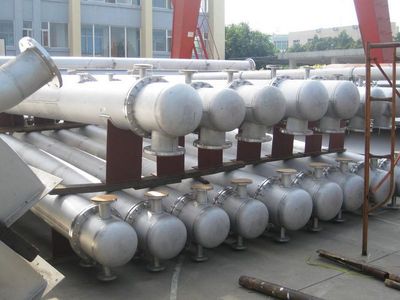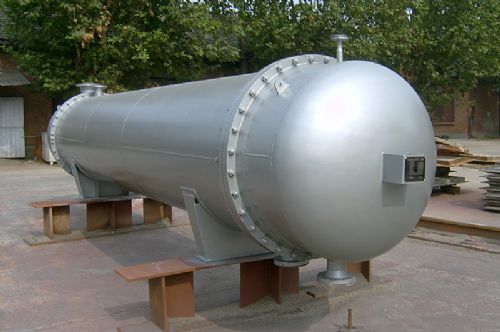Relevant Information
Installation and maintenance of shell and tube heat exchanger and instructions for use
- Categories:Company news
- Author:
- Origin:
- Time of issue:2021-05-20
- Views:0
(Summary description)Heat exchanger is a device that transfers part of the heat of the hot fluid to the cold fluid, also known as the heat exchanger. Heat exchangers are general equipment in chemical, petroleum, power, food and many other industrial sectors, and they occupy an important position in production. In chemical production, heat exchangers can be used as heaters, coolers, condensers, evaporators, and reboilers, and are more widely used.
Installation and maintenance of shell and tube heat exchanger and instructions for use
(Summary description)Heat exchanger is a device that transfers part of the heat of the hot fluid to the cold fluid, also known as the heat exchanger. Heat exchangers are general equipment in chemical, petroleum, power, food and many other industrial sectors, and they occupy an important position in production. In chemical production, heat exchangers can be used as heaters, coolers, condensers, evaporators, and reboilers, and are more widely used.
- Categories:Company news
- Author:
- Origin:
- Time of issue:2021-05-20
- Views:0
1. Product introduction:
Heat exchanger is a device that transfers part of the heat of the hot fluid to the cold fluid, also known as the heat exchanger. Heat exchangers are general equipment in chemical, petroleum, power, food and many other industrial sectors, and they occupy an important position in production. In chemical production, heat exchangers can be used as heaters, coolers, condensers, evaporators, and reboilers, and are more widely used.
2. Product features:
Shell and tube heat exchanger (also known as tube and tube) The heat exchanger is a shell and tube heat exchanger mainly composed of shell, tube bundle, tube sheet and head, etc. The shell is mostly circular, and there are parallel tube bundles inside. Or spiral tube, the tube bundle is fixed on the tube plate at both ends. This year, it has also been gradually promoted in the domestic market. The shell-and-tube heat exchanger and the spiral tube bundle design can maximize the turbulence effect and increase the heat exchange efficiency. The asymmetrical design of the inner shell and tube layer can be up to 4.6 times. This asymmetric design determines its wide application in the field of steam-water heat transfer. The shell and tube structure will greatly improve production efficiency and save costs.
3. Structural principle:
The condenser is a very important part of the four major components of refrigeration. It can transfer the heat in the tube to the air near the tube in a very fast manner. Most cars are placed in front of the water tank. A device that converts gas or vapor into liquid. Power plants use many condensers to condense the steam discharged from the turbine; in refrigeration plants, condensers are used to condense refrigerating steam such as ammonia and freon. In the petrochemical industry, condensers are used to condense hydrocarbons and other chemical vapors. In the distillation process, the device that converts vapor to liquid is called a condenser. All condensers operate by taking away the heat of gas or steam.
4. Installation
4.1.1 Venue and foundation
4.1.2 Sufficient space should be left at both ends of the heat exchanger to meet the needs of disassembly, assembly and maintenance.
4.1.3 The foundation and pre-embedded foundation bolts shall be made according to the dimensions provided in the as-built drawing of the heat exchanger.
4.1.4 Pressure test should generally be carried out before installation, and air tightness test should be carried out when the drawings are required.
4.1.5 Connect the pipeline according to the requirements of the nozzle table of the as-built drawing. Generally, when connecting the pipeline, a valve should be installed at the nozzle, and strong assembly should be avoided when connecting the pipe.
4.1.6 When tightening the foundation bolts of the heat exchanger, it should be carried out in diagonal order, and appropriate thread lubricant should be applied.
2, test run
2.1 Before the test run, the drawings should be consulted, whether there are special requirements and instructions, whether there are special signs on the nameplate, whether the tube plate is designed with differential pressure, and whether there are special requirements for pressure test and test procedures.
2.2 The entire system should be cleaned before the test run to prevent sundries and stolen goods from entering the heat exchanger.
2.3 If there is no bypass in the system, a temporary bypass should be added during the test run.
2.4 Open the vent and fill the tube with cold water (or cold fluid) first.
2.5 When the medium is steam, the residual liquid should be drained before driving to avoid the formation of water hammer and corrosive medium. After stopping, the residual medium should be drained.
2.6 During driving or parking, the temperature should be raised and lowered slowly to avoid excessive pressure difference and thermal shock.
3, maintenance,
3.1 The heat exchanger shall not operate beyond the conditions specified on the nameplate.
3.2 The inlet of the heat exchanger should be equipped with a decontamination device.
3.3 The cold circulating water of the heat exchanger should be softened water. It is recommended that the user install an electronic water treatment instrument or softened water equipment at the cold water inlet to avoid fouling of the heat exchanger and prevent the heat exchange tube from clogging or fouling.
3.4 The temperature drop of the tube and shell side media should be monitored frequently, and the leakage and fouling of the heat exchanger should be analyzed.
When the pressure drop increases and the heat transfer coefficient decreases beyond a certain value, an effective method should be selected for cleaning according to the structure of the medium and the heat exchanger.
3.5 The vibration of the tube bundle should be monitored frequently.
3.6 It should be noted that when not in use, the liquid in the equipment should be drained in winter to avoid freezing and cracking the equipment.
3.7 Take appropriate measures to prevent corrosion after decommissioning.
Scan the QR code to read on your phone
Lukou Factory (office): No. 33, Shenzhou Road, Lukou Street, Jiangning District, Nanjing
Gaochun Factory: No. 7, Taoyuan South Road, Gaochun Economic and Technological Development Zone, Nanjing
Nanjing Chengyi Industrial Technology Co., Ltd. 苏ICP备2020065522号-2 Technical support: www.300.cn Nanjing







